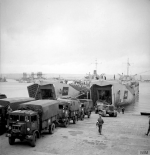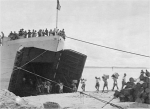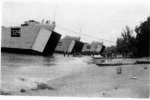NavSource Online: Amphibious Photo Archive
HM LST-324

LST-324 was transferred to the United Kingdom for the duration of World War II
Please report any broken links or trouble you might come across to the Webmaster. Please take a moment to let us know so that we can correct any problems and make your visit as enjoyable and as informative as possible.

Royal Navy History Commissioned into the Royal Navy as HM LST-324, 23 January 1943 HM LST-324 sailed from New York in company with HM LST-412 and HM LST-421, 13 March 1943 transporting refinery equipment to Curacao From Georgetown, Curacao HM LST-324 set sail for Freetown, Sierra Leone HM LST-324 participated in the following campaigns: Sicilian occupation Salerno landings West Coast of Italy operations-1944 - Anzio-Nettuno advanced landings Invasion of Normandy Operated in the shuttle service between Tilbury, Ostend and Antwerp Assisted in the liberation of the Channel islands HM LST-324 was reassigned to the Pacific Theater and participated in the Invasion of Malaya. Repatriated Australian troops to Brisbane > Paid off and returned to the US Navy at Subic Bay, Philippines, 4 May 1946
| Click On Image For Full Size Image |
Size | Image Description | Source | |
|---|---|---|---|---|
 |
14k | HM LST-324 heads for the Anzio beachhead, January 1944. Note the barrage balloon which was often flown from LST's to discourage strafing attacks by low-flying planes. Also of note is the British surface-search radar above LST-324's wheelhouse | US Navy DANFS | |
 |
77k | HM LST-361 and HM LST-324 loading vehicles and equipment at Gosport, England,
preparing for the upcoming Invasion of Normandy. Imperial War Museum War Office Second World War Official Collection, by Knight (Capt), Photo No. © IWM (H 38976). | Mike Green | |

US National Archives photo # 80-G-46817 |
370k | LSTs land invasion supplies on "Utah" Beach, shortly after the 6 June 1944 "D-Day" assault. LSTs on the beach include from (right to left): USS LST-312 HM LST-320 HM LST-321 USS LST-72 USS LST-51? last digit not visible) HM LST-324 USS LST-311 USS LST-49 USS LST-373 USS LST-47 and two unidentified LSTs. Note: bow numbers of the British ships enclosed in colored blocks; crowd of shipping offshore; barrage balloons over many of the ships. Photo was released for publication, 23 October 1944 US National Archives photo # 80-G-46817 a US Navy photo now in the collections of the US National Archives. Note: This image is labeled as Omaha Beach but is actually taken on Utah Beach. [See - The movie "A Newsreel Camaraman's View if D-Day" in color by Jack Lieb. About 15 minutes into the film Jack Lieb pans the beach one can see that this is Utah Beach showing LSTs 72, 324, 311, 46, 47 in the same sequence as in the NARA photo 80-G-46817.] |
Riley R. Re Qua MoMM3/C USS LST-49 and Arthur L Long MoMM2/C USS LST-49 Marilyn Smith for her father Coastguardsman Jack Davenport USCGC Blackhaw (WLB-390) |
|

US National Archives photo |
180k | |||
 |
61k | HM LST-324 sailing proudly up the Solent after returning from the Normandy beachhead sometime in June 1944. The dustbin aerial of her Type 217P radar unit can be seen just below the flags on her mast. | Robert Hurst | |
 |
68k | HM LST-324 unloading a cargo of timber from the United States at the West African port of Freetown, Sierra Leone. The timber was required for new docks and harbor works. Royal Navy photo # A 17840 from the collections of the Imperial War Museums. |
Robert Hurst | |
 |
50k | HM LST-324 and HM LST-412 unloading logs at Freetown, Sierra Leone, date unknown. | Robert Hurst | |
 |
30k | HM LST-324 beached at Sandakan, 27 October 1945. North East Borneo Force while loading tools and medical supplies. | Australian War Memorial | |

1016032405 |
229k | HM LST-324, HM LST-321 and HM LST-160 beached at Borneo in 1945 to
pickup repatriated Australian POWs and bring them back to Brisbane.
Simon Wilson's father served in HM LST-160 |
© Simon Wilson | |
| Back To The Navsource Photo Archives Main Page | Back To The Amphibious Ship Type Index | Back To The Tank Landing Ship (LST) Photo Index |
| Comments, Suggestions, E-mail Webmaster. |
|
This page is created and maintained by Gary P. Priolo |